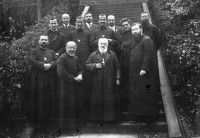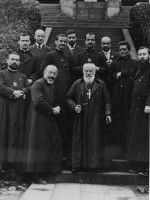February 9-15
We arrived in Nagasaki at 8:30 in the morning. We were warmly welcomed by Father Tilly, the caretaker of the Paris Mission, and soon arrived at the Cathedral, where we became guests of Bishop Comverts. After Mass, the Bishop received us like a father, embraced me, and expressed his great joy and gratitude that we had come to help his parish.
At Oura Cathedral in Nagasaki After we took the canonical vows, he gave us all the missionary powers under his authority. He allowed us to stay with him until our luggage arrived in Miyazaki, during which time we were able to tour the churches in Nagasaki, freely use the extensive and excellent library in the bishop's residence, and receive instruction in the Japanese language and the difficult aspects of Japanese evangelization under the guidance of the learned missionary, Father Lage [translator of the Japanese Classical Translation of the New Testament]. In this way, we were able to spend very meaningful days until February 15th, learning and observing.
[Places visited]
1) I went to the Italian consulate for our passport.
2) I have seen a school run by the Society of Mary. It is very thriving, with 700 students, of which 50 are Christians. It is government-approved, has a wonderful reference room, and is a fine concrete building. On the outskirts of Nagasaki, there is also a small seminary for training, set on a large site, with about 60 students.
3) I also went to the hill where the 26 Japanese Martyrs were martyred, and saw Urakami Cathedral, located on the outskirts of Nagasaki, where many generations of Christians live. At that time, about 600 mothers were holding a retreat.
4) We also visited the seminary, a beautiful building in a quiet, well-located location, housing some 40 seminarians.
5) We also visited a care home run by Japanese sisters, as well as the dormitory and novitiate of French sisters.
Thus, the Catholic work carried out by the missionaries is flourishing, showing that even in the midst of difficulties, good results can be produced and good vocations can be expected. The Japanese people are very thirsty for knowledge, open-minded and active.
So what about children and teenagers?
Oh, Father Rinaldi, there are many, many, many. They are skilled in all kinds of sports (especially tennis) and athletics. Just look at the children of the believers in Nagasaki! How devoutly they pray, how joyfully they serve Mass, and how well they sing, thanks to the example of their parents. At home, the parents do not pamper their children too much, but rather educate them to a certain extent in a strict manner.
There are about 60,000 Catholics in the Nagasaki area, accounting for the majority of the 80,000 in Japan as a whole. In terms of numbers, there are few missionaries. However, in order to care for the faithful who are scattered far and wide, they work admirably, working twice as hard as their counterparts, despite their advanced age.
6) We also saw other important sites, State Shinto and Buddhist temples.
The Pagans here have such a deep reverence for their temples and gods. It would be wonderful if some of us Catholics had the same respect.
The 11th was National Foundation Day, a national holiday, and everywhere was bustling with flags, processions, and school excursions. People call on God by ringing the bell when praying, and offer worship, donations, and prayers. Their actions are very serious. Putting aside the false beliefs, they are setting a great example.
February 16th [Trip to Miyazaki]
Finally, we received news that our luggage had arrived in Miyazaki, and we prepared to leave our welcoming nest and face the realities of life. After the Bishop gave each and every one of us some final lessons, blessings and words of encouragement, we were ready to set off to the mission field, but the Lord tested us: Brother Guaschino had been ill for the past few days with a sore throat and fever. Therefore, at the request of the Bishop, we decided to leave Fr. Marjaria behind in Nagasaki to accompany him.
At 1:30 pm on the 15th, Father Tilly took us to the station and we set off. (Omitted) On the way, beautiful scenery appeared before our eyes one after another, but we arrived in Kurume at 6pm and got off the train to visit Father Raoult's church at the Paris Mission. We decided to wait here until midnight, as we would arrive in Miyazaki during the day the next day.
At 1 a.m., we woke the group up and set off again. However, something unexpected happened again. This time, Father Livia Bella suddenly fell ill due to a chronic illness. Therefore, we asked the missionaries of the church to put him on the next train, and we set off alone.
We had to change trains on the way, but Japanese people are very gentlemanly. They immediately understood what we wanted to say even with the few words we said, and went out of their way to help us. The train conductors are very kind. When they opened the door to the train and entered, they first bowed deeply and said, "I'm sorry to trouble you, but may I see your ticket?" and "We're at station so and so now. Please make sure you haven't forgotten any of your luggage."
If you meet a believer on the way, you can easily distinguish him from thousands of others. He approaches without any hesitation, places his hands on his knees and bows deeply and politely. If he is wearing a hat, he first removes it and then bows, all with a smile and in a very natural way. This is a wonderful confession of faith in the midst of a multitude of heathens. The children, however, are even braver. They stand before us and bow beautifully. And in every greeting, they always bow with a sigh. It feels as if they are inhaling something good. (Omitted)

